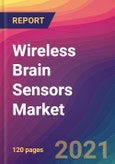Wireless brain sensors are devices that help detecting the intracranial pressure, monitor the temperature and record brain signaling in the form of brain waves. The devices are predominantly used for patients experiencing conditions such as traumatic brain injury, sleep disorders, Parkinson’s disease, dementia and other neurological conditions. These devices help in monitoring the neurological deviations and provide assistance for improvement of cognitive functionalities. These sensors can be easily accessible from a remote area via wireless connectivity and be integrated with smart phone, tablets or computers, thus be monitored periodically from a homecare environment making the device more cost-efficient. These sensors show a remunerative growth in the forecast period, 2021-2029.
The study report on wireless brain sensors market comprises of strategic insights, market evaluation and forecast assessment. Furthermore, the report also encompasses market size and analysis for the time scale 2019-2029.
Along with the quantitative aspects of the market the report also comprises of qualitative factors that enables one to gauge the market dynamics in terms of opportunities, drivers and restraints. The wireless brain sensors market is perceived as a much broadened market with maximum opportunities for expansion for the existing and emerging market players. Owing to lesser competitive pool in the market, it leads to birth of newer opportunities for the emerging industries to enter the market with their advanced technologies. An elaborative explanation of competitive landscape, market attraction, industrial partnership and ongoing developments in the wireless brain sensors market has been incorporated in this report. Profiles for the existing market players that dominate the current wireless brain sensors market has also been provided. The industries profiled in this report are EMOTIV Inc., Muse, NeuroSky, Advanced Brain Monitoring, Inc., & Neuroelectrics.
This product will be delivered within 2 business days.
The study report on wireless brain sensors market comprises of strategic insights, market evaluation and forecast assessment. Furthermore, the report also encompasses market size and analysis for the time scale 2019-2029.
In the current report the wireless brain sensors market was studied by categorizing the market into various segments which are as follows:
- By Product Type
- Electroencephalography (EEG) Devices
- Sleep Monitoring Devices
- Accessories
- Electrodes
- Chips
- By Application
- Traumatic Brain Injuries
- Dementia
- Parkinson’s Disease
- Epilepsy
- Sleep Disorders
- Migraine
- Stroke
The wireless brain sensors market has also been studied based on the outreach of these devices amongst geographies. The market analysis and forecast assessment for various geographies included in this report are:
- North America
- U.S.
- Canada
- Europe
- U.K.
- Germany
- Rest of Europe
- Asia Pacific
- Japan
- China
- India
- Rest of Asia Pacific
- Latin America Middle East and Africa
- Brazil
- Mexico
- Rest of Latin America
- Middle East and Africa
- GCC
- Rest of Middle East and Africa
Along with the quantitative aspects of the market the report also comprises of qualitative factors that enables one to gauge the market dynamics in terms of opportunities, drivers and restraints. The wireless brain sensors market is perceived as a much broadened market with maximum opportunities for expansion for the existing and emerging market players. Owing to lesser competitive pool in the market, it leads to birth of newer opportunities for the emerging industries to enter the market with their advanced technologies. An elaborative explanation of competitive landscape, market attraction, industrial partnership and ongoing developments in the wireless brain sensors market has been incorporated in this report. Profiles for the existing market players that dominate the current wireless brain sensors market has also been provided. The industries profiled in this report are EMOTIV Inc., Muse, NeuroSky, Advanced Brain Monitoring, Inc., & Neuroelectrics.
Based on the type of product, the global wireless brain sensors market is segmented as follows:
- Electroencephalography (EEG) Devices
- Sleep Monitoring Devices
- Accessories
- Electrodes
- Chips
Based on the application, the global wireless brain sensors market is segmented as follows:
- Traumatic Brain Injuries
- Dementia
- Parkinson’s Disease
- Epilepsy
- Sleep Disorders
- Migraine
- Stroke
For the purpose of this study, the wireless brain sensors market is categorized into:
- North America
- Europe
- Asia Pacific
- Latin America (LATAM)
- Middle East and Africa (MEA)
This product will be delivered within 2 business days.
Table of Contents
Chapter 1. Preface
Chapter 2. Executive Summary
Chapter 3. Wireless Brain Sensors Market: Market Dynamics and Future Outlook
Chapter 4. Wireless Brain Sensors Market, by Product Type, 2019 - 2029 (US$ Mn)
Chapter 5. Wireless Brain Sensors Market, by Application, 2019 - 2029 (US$ Mn)
Chapter 6. Global Wireless Brain Sensors Market, by Geography, 2019 - 2029 (US$ Mn)
Chapter 7. Company Profiles
Companies Mentioned
- Advanced Brain Monitoring Inc.
- EMOTIV Inc.
- Evolent Health Inc.
- Muse
- Neuroelectrics
- NeuroSky.








